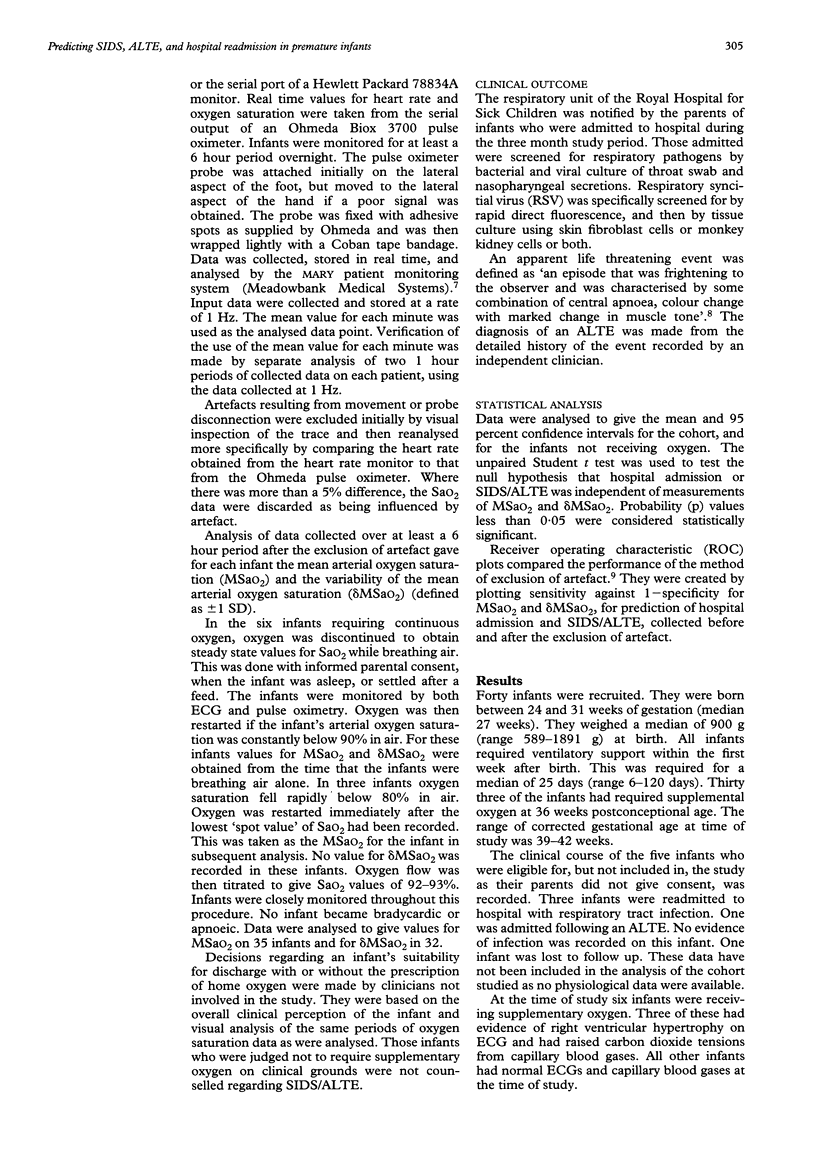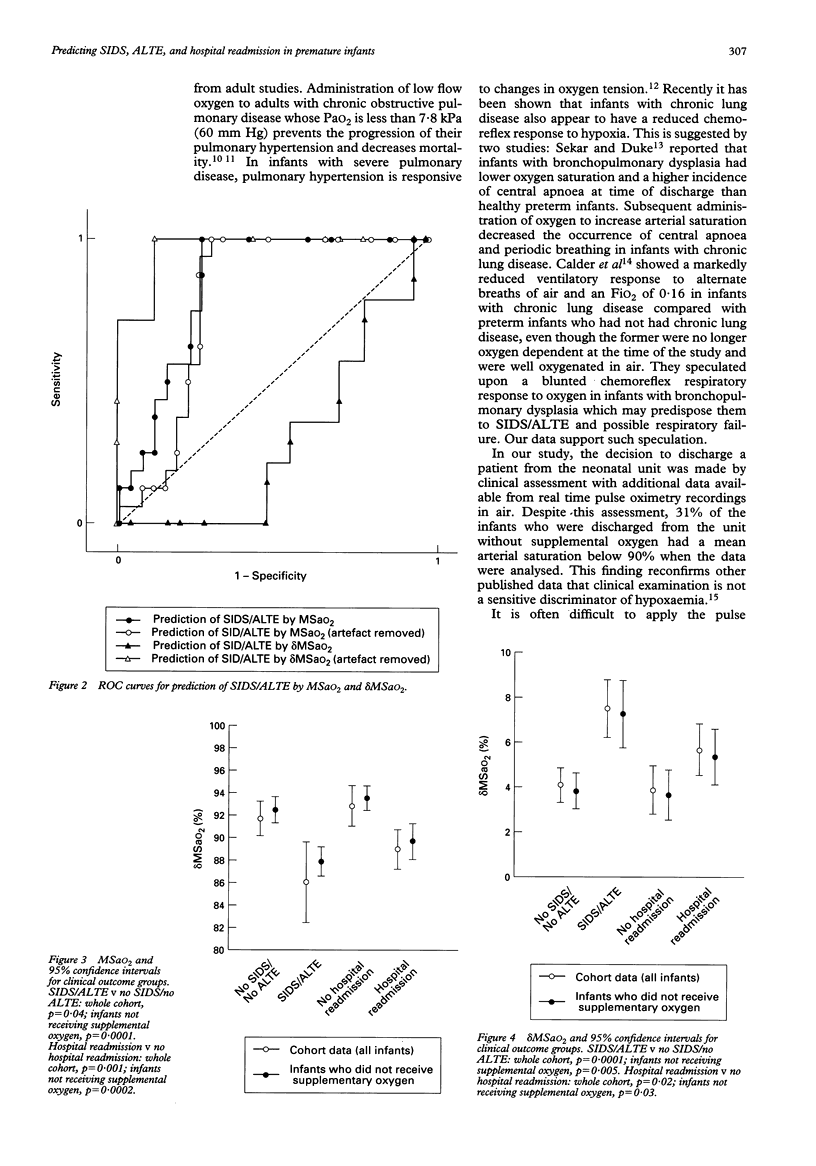Abstract
In an attempt to identify those infants with resolving chronic lung disease of prematurity (CLD) at greatest risk of sudden infant death syndrome or acute life threatening event (SIDS/ALTE), or readmission to hospital following discharge, recordings of arterial oxygen saturation were made on 35 infants. Recordings were collected while the infants were breathing room air. Movement artefact was excluded and the data analysed to provide the mean individual arterial oxygen saturation (MSaO2), and the variability of the mean individual oxygen saturation (delta MSaO2). These data were related to clinical outcome recorded over the three months following investigation. A MSaO2 less than 90% on discharge predicted hospital admission within three months with a sensitivity of 1 and a specificity of 0.76, and SIDS/ALTE with a sensitivity of 1 and a specificity of 0.75. A delta MSaO2 greater than 6% predicted SIDS/ALTE with a sensitivity 0.88 and specificity of 1. Infants with resolving chronic lung disease of prematurity who are at risk of increased morbidity and mortality can be assessed by accurate measurement of mean arterial saturation.
Full text
PDF




Selected References
These references are in PubMed. This may not be the complete list of references from this article.
- Abman S. H., Burchell M. F., Schaffer M. S., Rosenberg A. A. Late sudden unexpected deaths in hospitalized infants with bronchopulmonary dysplasia. Am J Dis Child. 1989 Jul;143(7):815–819. doi: 10.1001/archpedi.1989.02150190065022. [DOI] [PubMed] [Google Scholar]
- Altman D. G., Bland J. M. Diagnostic tests 3: receiver operating characteristic plots. BMJ. 1994 Jul 16;309(6948):188–188. doi: 10.1136/bmj.309.6948.188. [DOI] [PMC free article] [PubMed] [Google Scholar]
- Bancalari E., Abdenour G. E., Feller R., Gannon J. Bronchopulmonary dysplasia: clinical presentation. J Pediatr. 1979 Nov;95(5 Pt 2):819–823. doi: 10.1016/s0022-3476(79)80442-4. [DOI] [PubMed] [Google Scholar]
- Baudouin S. V., Waterhouse J. C., Tahtamouni T., Smith J. A., Baxter J., Howard P. Long term domiciliary oxygen treatment for chronic respiratory failure reviewed. Thorax. 1990 Mar;45(3):195–198. doi: 10.1136/thx.45.3.195. [DOI] [PMC free article] [PubMed] [Google Scholar]
- Calder N. A., Williams B. A., Smyth J., Boon A. W., Kumar P., Hanson M. A. Absence of ventilatory responses to alternating breaths of mild hypoxia and air in infants who have had bronchopulmonary dysplasia: implications for the risk of sudden infant death. Pediatr Res. 1994 Jun;35(6):677–681. doi: 10.1203/00006450-199406000-00011. [DOI] [PubMed] [Google Scholar]
- Halliday H. L., Dumpit F. M., Brady J. P. Effects of inspired oxygen on echocardiographic assessment of pulmonary vascular resistance and myocardial contractility in bronchopulmonary dysplasia. Pediatrics. 1980 Mar;65(3):536–540. [PubMed] [Google Scholar]
- Kelleher J. F., Ruff R. H. The penumbra effect: vasomotion-dependent pulse oximeter artifact due to probe malposition. Anesthesiology. 1989 Nov;71(5):787–791. [PubMed] [Google Scholar]
- Northway W. H., Jr, Rosan R. C., Porter D. Y. Pulmonary disease following respirator therapy of hyaline-membrane disease. Bronchopulmonary dysplasia. N Engl J Med. 1967 Feb 16;276(7):357–368. doi: 10.1056/NEJM196702162760701. [DOI] [PubMed] [Google Scholar]
- Sauve R. S., McMillan D. D., Mitchell I., Creighton D., Hindle N. W., Young L. Home oxygen therapy. Outcome of infants discharged from NICU on continuous treatment. Clin Pediatr (Phila) 1989 Mar;28(3):113–118. doi: 10.1177/000992288902800301. [DOI] [PubMed] [Google Scholar]
- Sekar K. C., Duke J. C. Sleep apnea and hypoxemia in recently weaned premature infants with and without bronchopulmonary dysplasia. Pediatr Pulmonol. 1991;10(2):112–116. doi: 10.1002/ppul.1950100213. [DOI] [PubMed] [Google Scholar]
- Shennan A. T., Dunn M. S., Ohlsson A., Lennox K., Hoskins E. M. Abnormal pulmonary outcomes in premature infants: prediction from oxygen requirement in the neonatal period. Pediatrics. 1988 Oct;82(4):527–532. [PubMed] [Google Scholar]
- Tammela O. K., Koivisto M. E. A 1-year follow-up of low birth weight infants with and without bronchopulmonary dysplasia: health, growth, clinical lung disease, cardiovascular and neurological sequelae. Early Hum Dev. 1992 Sep;30(2):109–120. doi: 10.1016/0378-3782(92)90139-8. [DOI] [PubMed] [Google Scholar]
- Thilo E. H., Andersen D., Wasserstein M. L., Schmidt J., Luckey D. Saturation by pulse oximetry: comparison of the results obtained by instruments of different brands. J Pediatr. 1993 Apr;122(4):620–626. doi: 10.1016/s0022-3476(05)83549-8. [DOI] [PubMed] [Google Scholar]
- Timms R. M., Khaja F. U., Williams G. W. Hemodynamic response to oxygen therapy in chronic obstructive pulmonary disease. Ann Intern Med. 1985 Jan;102(1):29–36. doi: 10.7326/0003-4819-102-1-29. [DOI] [PubMed] [Google Scholar]
- Wang E. E., Milner R. A., Navas L., Maj H. Observer agreement for respiratory signs and oximetry in infants hospitalized with lower respiratory infections. Am Rev Respir Dis. 1992 Jan;145(1):106–109. doi: 10.1164/ajrccm/145.1.106. [DOI] [PubMed] [Google Scholar]


